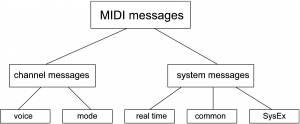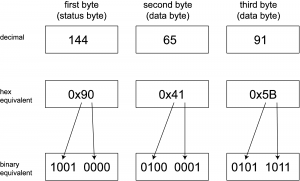6.1.5.1 Binary, Decimal, and Hexadecimal Numbers
When you read about MIDI message formats or see them in software interfaces, you’ll find that they are sometimes represented as binary numbers, sometimes as decimal numbers, and sometimes as hexadecimal numbers (hex, for short), so you should get comfortable moving from one base to another. Binary is base 2, decimal is base 10, and hex is base 16. You can indicate the base of a number with a subscript, as in 011111002, 7C16, and 12410. Often, 0x is placed in front of hex numbers, as in 0x7C. Some sources use an H after a hex number, as in 7CH. Usually, you can tell by context what base is intended, and we’ll omit the subscript unless the context is not clear. We assume that you understand number bases and can convert from one to another. If not, you should easily be able to find a resource on this for a quick crash course.
Binary and hexadecimal are useful ways to represent MIDI messages because they allow us to divide the messages in meaningful groups. A byte is eight bits. Half a byte is four bits, called a nibble. The two nibbles of a MIDI message can encode two separate pieces of information. This fact becomes important in interpreting MIDI messages, as we’ll show in the next section. In both the binary and hexadecimal representations, we can see the two nibbles as two separate pieces of information, which isn’t possible in decimal notation.
A convenient way to move from hexadecimal to binary is to translate each nibble into four bits and concatenate them into a byte. For example, in the case of 0x7C, the 7 in hexadecimal becomes 0111 in binary. The C in hexadecimal becomes 1100 in binary. Thus 0x7C is 01111100 in binary. (Note that the symbols A through F correspond to decimal values 10 through 15, respectively, in hexadecimal notation.)
6.1.5.2 MIDI Messages, Types, and Formats
In Section 6.1.3, we showed you an example of a commonly used MIDI message, Note On, but now let’s look at the general protocol.
MIDI messages consist of one or more bytes. The first byte of each message is a status byte, identifying the type of message being sent. This is followed by 0 or more data bytes, depending on the type of message. Data bytes give more information related to the type of message, like note pitch and velocity related to Note On.
All status bytes have a 1 as their most significant bit, and all data bytes have a 0. A byte with a 1 in its most significant bit has a value of at least 128. That is, 10000000 in binary is equal to 128 in decimal, and the maximum value that an 8 bit binary number can have (11111111) is the decimal value 255. Thus, status bytes always have a decimal value between 128 and 255. This is 10000000 through 11111111 in binary and 80 through FF in hex.
[wpfilebase tag=file id=41 tpl=supplement /]
MIDI messages can be divided into two main categories: Channel messages and System messages. Channel messages contain the channel number. They can be further subdivided into voice and mode messages. Voice messages include Note On, Note Off, Polyphonic Key Pressure, Control Change, Program Change, Channel Pressure/Aftertouch, and Pitch Bend. A mode indicates how a device is to respond to messages on a certain channel. A device might be set to respond to all MIDI channels (called Omni mode), or it might be instructed to respond to polyphonic messages or only monophonic ones. Polyphony involves playing more than one note at the same time.
System messages are sent to the whole system rather than a particular channel. They can be subdivided into Real Time, Common, and System Exclusive messages (SysEx). The System Common messages include Tune Request, Song Select, and Song Position Pointer. The system real time messages include Timing Clock, Start, Stop, Continue, Active Sensing, and System Reset. SysEx messages can be defined by manufacturers in their own way to communicate things that are not part of the MIDI standard. The types of messages are diagrammed in Figure 6.15. A few of these messages are shown in Table 6.1.

[table caption=”Table 6.1 Examples of MIDI messages” width=”80%”]
Hexadecimal*,Binary**,Number of Data Bytes,Description
Channel Voice Messages[attr colspan=”4″ style=”text-align:center;font-weight:bold”]
8n,1000mmmm,2,Note Off
9n,1001mmmm,2,Note On
An,1010mmmm,2,Polyphonic Key Pressure/Aftertouch
Bn,1011mmmm,2,Control Change***
Cn,1100mmmm,1,Program Change
Dn,1101mmmm,1,Channel Pressure/Aftertouch
En,1110mmmm,2,Pitch Bend Change
Channel Mode Messages[attr colspan=”4″ style=”text-align:center;font-weight:bold”]
Bn,1101mmmm,2,Selects Channel Mode
System Messages[attr colspan=”4″ style=”text-align:center;font-weight:bold”]
F3,11110011,1,Song Select
F8,11111000,0,Timing Clock
F0,11110000,variable,System Exclusive
*Each n is a hex digit between 0 and F. [attr colspan=”4″]
**Each m is a binary digit between 0 and 1.[attr colspan=”4″]
***Channel Mode messages are a special case of Control Change messages. The difference is in the first data byte. Data byte values 0x79 through 0x7F have been reserved in the Control Change message for information about mode changes.[attr colspan=”4″]
[/table]
[wpfilebase tag=file id=124 tpl=supplement /]
Consider the MIDI message shown in all three numerical bases in Figure 6.16. In the first byte, the most significant bit is 1, identifying this as a status byte. This a Note On message. Since it is a channel message, it has the channel in its least significant four bits. These four bits can range from 0000 to 1111, corresponding to channels 1 through 16. (Notice that the binary value is one less than the channel number as it appears on our sequencer interface. A Note On message with 0000 in the least significant nibble indicates channel 1, one with 0001 indicates channel 2, and so forth.)
A Note On message is always followed by two data bytes. Data bytes always have a most significant bit of 0. The note to be played is 0x41, which translates to 65 in decimal. By the MIDI standard, note 60 on the keyboard is middle C, C4. Thus, 65 is five semitones above middle C, which is F4. The second data byte gives the velocity of 0x5B, which in decimal translates to 91 (out of a maximum 127).
